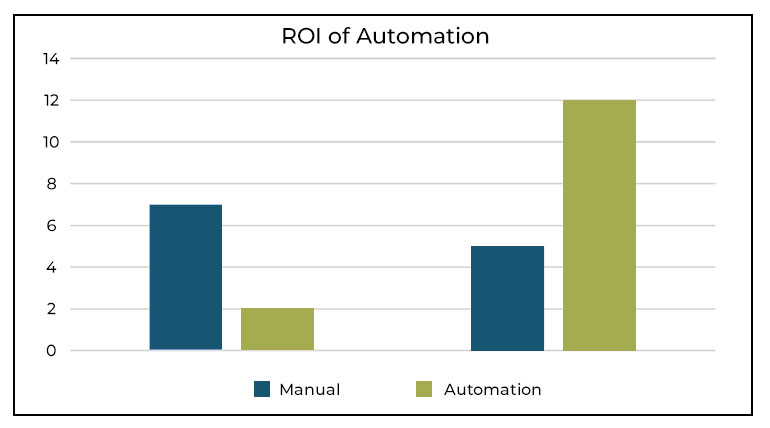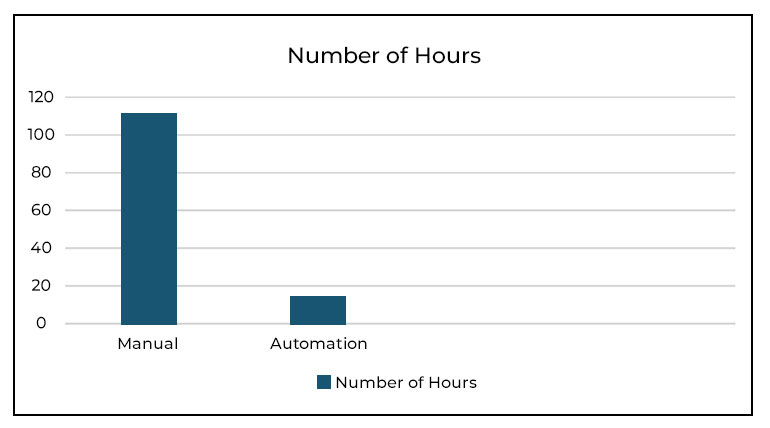Here is Your ROI with Test Automation
Why do we need automation?
Well, software testing is the process of finding bugs that are hidden in a piece of software. Even though testing takes time and resources, we should always pay attention. Since testing software is a lot of work, especially if done by hand, automation sounds great immediately.
Every company’s success depends on how fast it can get its products to market. When products come out late, they can lose money, customers, and market share. Companies switch to automated testing to avoid these problems, which will help them solve them.
Below listed are some significant benefits of Automation testing.
- Faster time to market and instant feedback to the developer.
- Save time, effort, and money.
- Higher test coverage.
- Improved accuracy.
Okay, and why do we need to calculate ROI on automation?

Any QA team that wants to implement automation needs to plan, do it carefully, and use people who know and understand all the complexities. On top of all of these problems, they also need money.
The cost is very high, which leads back to the most basic and essential question: Will automation give a good ROI? You can’t automate all test cases, which is why most companies use a mix of manual and automated testing methods.
Even though automation testing is better than manual testing in most cases, we need to keep an eye on test automation’s short-term and long-term savings. Some Key Performance Indicators (KPIs), like saving man hours, speeding up execution cycles, giving developers immediate feedback, etc., can’t be measured in terms of money, but they help speed up releases.
Automation requires a big initial investment in software functional analysis, scripting, tools, training, licensing costs, etc. When we measure something, we can determine how well it works and keep it in check. To plan and keep track of everything, you need to measure. Because of this, it is vital to accurately measure the return on investment of test automation (ROI). ROI shows that the work is worth it and is also important for planning a project.
How to measure ROI for Automation?

Before we dig into the different ways to measure and improve the ROI of test automation, let’s first look at how the ROI of automation is calculated. The formula for ROI calculation will remain the same regardless of the size and the scale of automation.
ROI (Return On Investment) = Savings / Investment
Savings: Amount of time/man hours saved as a result of switching from manual to automated testing (besides other intangible/abstract advantages)
Investment: Establishing the automation infrastructure’s costs in the team, including the time spent building the test automation framework, coding, and maintenance.
Savings can be an immediate financial benefit or result in man-hours/time savings. And whether the tests are performed using the in-house testing infrastructure or other readily available cloud-based infrastructure, they will still count as a Cost/Expenditure to the company.
These costs fall under the category of “Investments,” with the expectation that they will pay off both soon (short-term) and later (long-term). A positive ROI is considered if a faster test infrastructure investment results in enormous time savings, resulting in more immediate product delivery.
Let us look at a case study to understand better
Let’s take an example of a globally recognized technology service provider company. Implementing Automation in their testing lifecycle helped them with a wide variety of scenarios that manual testing could not handle.
The automation suite covered various payment methods and countries and validated different user authentication types quickly and accurately. Before implementing automation, let’s say 3 manual testers were working on this project. To start/implement automation, 2 automation engineers joined the team.
As the automation scripting gains considerable pace and more and more tests are automated, and the suite is fully implemented, the testing team can be reduced to 1 manual and 1 automation engineer, which will result in significant resource and man-hours savings.


When figuring out the return on investment for test automation, we need to look at the big picture and consider a longer time frame. It’s not ideal to figure out the ROI of automation in less time. Test automation costs money upfront and on an ongoing basis, but it pays for itself as it is used, and putting it in place early in the SDLC can lead to big gains. A company can get back its investment in automation in a year by doing more automated and less manual testing.
How to improve automation’s return on investment
If you automate your tests well, you can get more out of the time and effort you put in. It’s essential to work on a well-thought-out plan over time if you want your automation testing to keep giving you accurate and reliable results. So, to get the most return on investment (ROI) from automation, it’s best to estimate the ROI and understand the factors that can change and improve it. Here are some necessary things to think about if you want to improve the ROI.
Setting the scope of the automation
We need to figure out what we should automate. When deciding what to automate, it is vital to consider the functional parts of the application being tested, the environment, hardware dependencies, possible effects, and more. Here are some of the best tasks that could be done automatically.
- Test cases that are repetitive and need a lot of human intervention;
- Test cases that won’t change in the following sprints;
- Test cases that must be run with a lot of data;
- Areas that are important to the business.
- Projects that do a lot of regression testing.
- Robust Test design
The design of tests is a key part of increasing test automation’s return on investment (ROI). A robust test design tries to cover all of the code with as few tests as possible and in as little time. The test design should be more efficient and have parts that can be used more than once. This will make maintenance much easier and save a lot of time. Because the UI of an app might change between releases, test scripts should be able to fix themselves.
Use of standard tools and frameworks for automating tasks
Regarding testing, having the proper automation framework can make the whole process much more productive and save time and effort. The automation tool and framework you choose should work for your test cases and the application you are testing. Choosing the right framework will make it easier to use and perform better in the long run. Except for the test scripts, a framework should have everything you need for an automation solution. It should also fit well with the ecosystem, where applications are often changed, and new code is released. Here are some things that any automation framework should have:
- Ease of use
- Scalability
- Support for all browsers
- Data-driven support
- Email alerts and reports
- Support for CI/CD integration.
Test Data
For test automation to work, you must ensure that the test data quality includes all the necessary information and parts for the Application under Test. The test data should be put into different groups, such as valid, invalid, BVA, and EVP. A data-driven testing approach should be used when an external data source feeds many test data variations into a test case in a controlled way to test the development code thoroughly. It is essential to check the validity of the test data every so often to ensure that the data you use for testing is up-to-date.
Test Maintenance
It can be hard to write automated tests for apps that often change user interfaces and functions. The automated test scripts might not work for later builds or versions of an application. This means that a test automation solution with reusable test cases needs to be made up of smaller, more specific test cases. Also, the tests need to be made so that the change to the user interface doesn’t affect them. Instead of only running the test scripts right before a release, there should be a plan to keep them in good shape and ensure they are always up to date.
Cloud-based infrastructure
Cloud infrastructure is vital to automation testing that works well and increases ROI. Because it’s getting harder to handle and manage different browsers and platforms, Cloud providers can keep multiple platforms, browsers, and devices up-to-date with updates, security patches, and operating system upgrades while lowering the cost per unit of testing.
Conclusion
Automating software tests has become a meaningful way to speed up deployment and get products to market faster, which is the key to success. QA (Quality Assurance) reaches a whole new peak when mistakes made by people are cut down. Based on what has been said, test automation should be seen as a way to improve overall quality and productivity, not just to save money. But the ROI metric is essential for figuring out how well test automation will work before it is put into place. This will help with making strategic decisions. When business leaders and technical teams know more about the return on investment of your test automation efforts, they will better understand how to test speed, robustness, and other factors that affect things (ROI).
















